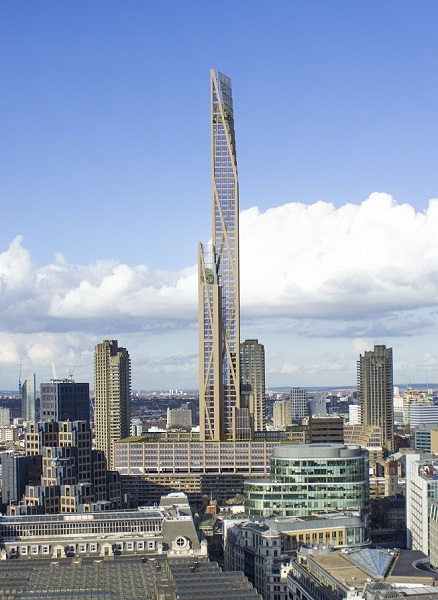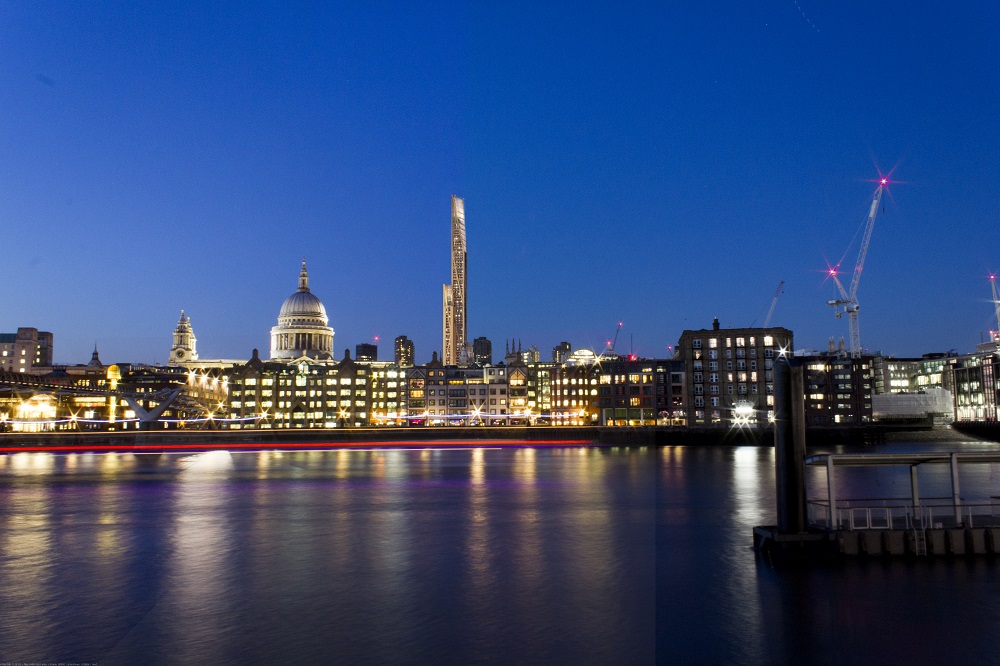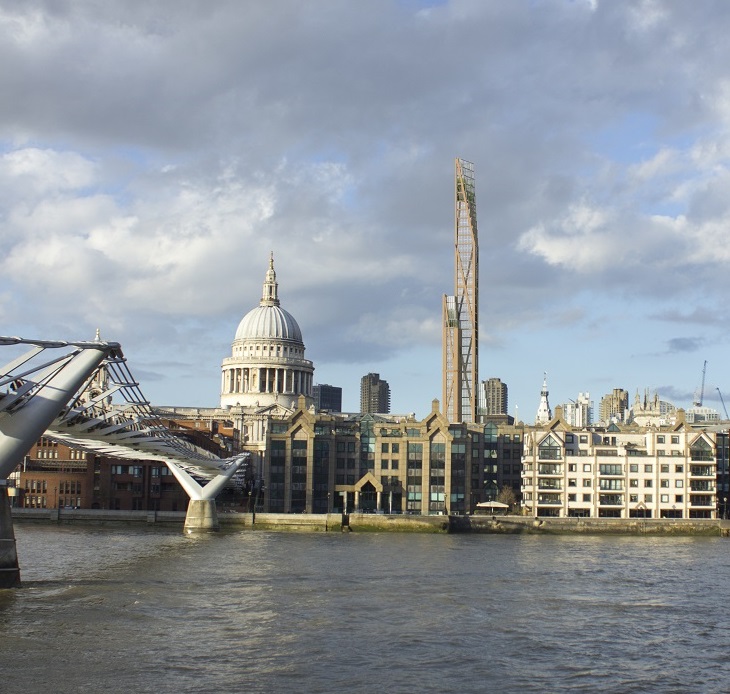Timber construction for London
In April 2016, researchers presented the Mayor of London with conceptual plans for the city’s first timber skyscraper, integrated within the Barbican. At 300 metres in height, the tower would be the second tallest building in London after The Shard.
At present, the world’s tallest timber building is a 14-storey apartment block in Bergen, Norway.
The design for the 80-storey structure is the first in a series of timber skyscrapers developed by Cambridge University’s Department of Architecture in association with PLP Architecture and structural engineers Smith and Wallwork with funding from the UK’s Engineering and Physical Sciences Research Council (EPSRC).
The use of timber as a structural material in tall buildings is an area of emerging interest because of a range of potential benefits, the most obvious being that it is a renewable resource. The type of timber these new buildings is regarded as a ‘crop’. The amount of crop forest in the world is currently expanding. Canada alone could produce more than 15billion m³ of crop forest in the next 70 years, enough to house around a billion people.
The research is also investigating other potential benefits, such as reduced costs and improved construction timescales, increased fire resistance, and a significant reduction in overall weight.
The conceptual proposals currently being developed would create over 1,000 new residential units in a 1 million sq ft mixed-use tower and mid-rise terraces in central London. In addition, the design team claims that the buildings would:
- Use around 65,000 m3 of structural timber.
- Use structural softwood from PEFC or FSC certified forests.
- Lock-in 50,000 tCO2 in the building timber frame, equivalent to the annual CO2 emissions of 5,000 Londoners.
- Displace more CO2 intensive materials such as steel or concrete, creating additional CO2 savings.
- Be four times lighter than the concrete equivalent.
- Be quicker and quieter to build when compared to conventional construction, as timber structures reduce construction traffic. One timber lorry delivers the equivalent of five concrete lorries.
Perhaps the most obvious concern for potential residents of homes built primarily from timber is fire risk. However, the team involved in the project said the proposed building would eventually meet or exceed every existing fire regulation currently in place for steel and concrete buildings.
Research has shown that timber buildings can have positive effects on their user and occupant’s health. Some recent studies have also shown that children taught in schools with timber structures may perform better than in those made of concrete.
The tall timber buildings research also looks towards creating new designs with timber buildings, rather than simply copying the forms of steel and concrete construction. The transition to timber construction may have a wider positive impact on urban environments and built form, and offers opportunities not only to rethink the aesthetics of buildings, but also the structural methodologies informing their design.
The designers believe that just as major innovations in steel, glass, concrete revolutionised buildings in the 19th and 20th centuries, creating new typologies such as Joseph Paxton’s Crystal Palace and the Parisian arcades described by Walter Benjamin, innovations in timber construction could lead to entirely new experiences of the city in the 21st century.
Kevin Flanagan, Partner at PLP Architecture said:
“We now live predominantly in cities and so the proposals have been designed to improve our wellbeing in an urban context. Timber buildings have the potential architecturally to create a more pleasing, relaxed, sociable and creative urban experience. Our firm is currently designing many of London’s tall buildings, and the use of timber could transform the way we build in this city. We are excited to be working with the University and with Smith and Wallwork on this ground breaking design- and engineering-based research.”
Simon Smith of Smith and Wallwork engineers said:
“Timber is our only renewable construction material and in its modern engineered form it can work alongside steel and concrete to extend and regenerate our cities. It is only a matter of time until the first timber skyscraper is built”.
Dr Michael Ramage, Director of Cambridge’s Centre for Natural Material Innovation, said:
“If London is going to survive it needs to increasingly densify. One way is taller buildings. We believe people have a greater affinity for taller buildings in natural materials rather than steel and concrete towers. The fundamental premise is that timber and other natural materials are vastly underused and we don’t give them nearly enough credit. Nearly every historic building, from King’s College Chapel to Westminster Hall, has made extensive use of timber.
“We’ve designed the architecture and engineering and demonstrated it will stand, but this is at a scale no one has attempted to build before. We are developing a new understanding of primary challenges in structure and construction. There is a lot of work ahead, but we are confident of meeting all the challenges before us.”
Images and content courtesy of PLP Architecture.
[edit] Find out more
[edit] Related articles on Designing Buildings Wiki
- Built environment.
- Chip carving.
- Densification.
- Designing smart cities.
- Forests.
- Glulam.
- HAUT, Amsterdam.
- Hyperion, Bordeaux.
- Laminated veneer lumber LVL.
- Skyscraper.
- Sustainable materials.
- Tallest buildings in the world.
- Tallest timber building in the world.
- The Shard.
- The skyscrapers of the future will be made of wood.
- Timber.
- Tratoppen, Stockholm.
- Unusual building design of the week.
Featured articles and news
Government consultations for the summer of 2025
A year of Labour, past and present consultations on the environment, the built environment, training and tax.
CMA competitiveness probe of major housing developers
100 million affordable housing contributions committed with further consultation published.
Homes England supports Greencore Homes
42 new build affordable sustainable homes in Oxfordshire.
Zero carbon social housing: unlocking brownfield potential
Seven ZEDpod strategies for brownfield housing success.
CIOB report; a blueprint for SDGs and the built environment
Pairing the Sustainable Development Goals with projects.
Types, tests, standards and fires relating to external cladding
Brief descriptions with an extensive list of fires for review.
Latest Build UK Building Safety Regime explainer published
Key elements in one short, now updated document.
UKGBC launch the UK Climate Resilience Roadmap
First guidance of its kind on direct climate impacts for the built environment and how it can adapt.
CLC Health, Safety and Wellbeing Strategy 2025
Launched by the Minister for Industry to look at fatalities on site, improving mental health and other issues.
One of the most impressive Victorian architects. Book review.
Common Assessment Standard now with building safety
New CAS update now includes mandatory building safety questions.
RTPI leader to become new CIOB Chief Executive Officer
Dr Victoria Hills MRTPI, FICE to take over after Caroline Gumble’s departure.
Social and affordable housing, a long term plan for delivery
The “Delivering a Decade of Renewal for Social and Affordable Housing” strategy sets out future path.
A change to adoptive architecture
Effects of global weather warming on architectural detailing, material choice and human interaction.
The proposed publicly owned and backed subsidiary of Homes England, to facilitate new homes.
How big is the problem and what can we do to mitigate the effects?
Overheating guidance and tools for building designers
A number of cool guides to help with the heat.
The UK's Modern Industrial Strategy: A 10 year plan
Previous consultation criticism, current key elements and general support with some persisting reservations.
Building Safety Regulator reforms
New roles, new staff and a new fast track service pave the way for a single construction regulator.




























Comments
Great engineering - wonderful to see this technical advance. However, the location seems ill-advised - probably better to put this building in Docklands.